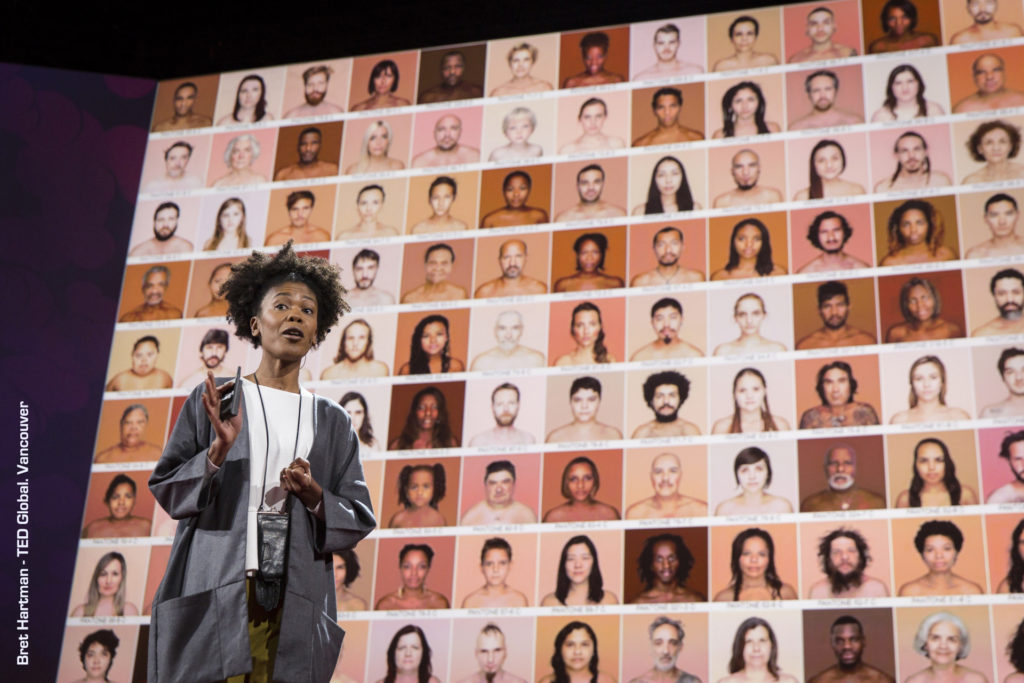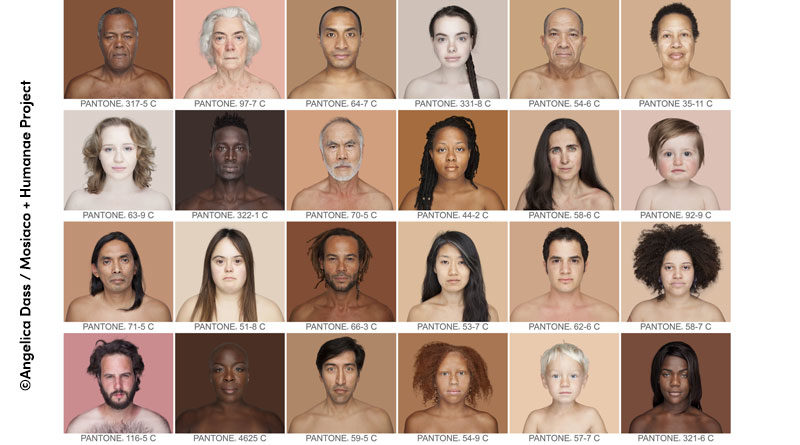Angelica Dass, the struggle for humanity and its beauty.
By Pietra Diwan
When I watched Angelica Dass speaking for the first time, I was teaching a lesson during a photography class to a 12 years old girl. It happens to be one of the most touching TED talks I ever saw. I ended the lesson with teared eyes explaining to my student why art, in this case, photography, can make a big impact in the world. Days after I contacted the artist to know more about her initiative. I’ve got even more impressed by her presence and determination.
Ms. Dass is the award-winning photographer and creator of Humanae Project, a work-in-progress database of skin tones or as the website describe, “a collection of portraits that reveal the diverse beauty of human colors”. Until now, Angelica traveled 20 countries and took more than 2,500 portraits. Her creation has traveled worldwide, but in 2016, she got famous for the TED Talk “The beauty of human skin in every color” that goes far beyond photography.
Angelica shows throughout her portraits that skin color is nothing more than a shade in the Pantone scale, and a historical construct. She advocates for social change, promotes dialogues, and challenges cultural prejudices. Today, her talk has more than 2.5 million views and it was translated to 34 languages. She started in 2012, but still, she is convinced that her work is far from ending.
It will be easy if we define Humanae and Angelica’s work only like a photographer and her framed art hanging in an art gallery or museum. No, we can’t do that. Angelica Dass creation is an opportunity to show and discuss our humaneness. Self-defined a storyteller, Angelica, can be seen also as an activist that doesn’t miss opportunities of speaking out not only in regards to race but for what makes us equal, more than different. Her work it’s like a big portal that opens up to a more complex understanding in how modern society has supported and reproduced stereotypes and prejudices as naturalized actions.

Today, we see people speaking and acting with racism without even notice it. It’s mandatory to act now. For Angelica, see, listen, read, think, digest, process, and act are some of the necessary steps to make the change. It’s not a simple and quick switch or a click button that will end racism and intolerance. Society as a whole has to do the work, one person at a time, that includes individual reflections, and personal stories of supporting, silencing, and being indifferent when seeing a racist act or comment. This is why Humanae is so important.
Her open concept artwork is having a big impact educating younger populations. The Humanae Project lead to the creation of a non-profit institute that helps teachers, and educators make children think critically about race, identity, and the labels that separate us. She collaborates with several educators and schools around the world, but especially in Madrid (Spain) where she has residence. The workshops make people reflect – at every age level – when doing their self-portrait about identity in a critical manner. She mentioned that elderly are especially touched when viewing themselves in the mirror. Last year, students from the Portuguese Program at Downtown Doral Upper Charter School had the opportunity to do her workshop with the support of the Humanae Institute and Angelica’s workshop initiative.
Since 2012 Humanae is collecting around the world portraits of people in a pursuit to document humanity’s true colors rather than the untrue white, red, black, and yellow that are associated with race for centuries. According with Angelica “I’ll keep working with Humanae because it is necessary. Until I won’t stop being dehumanized because of the way I am, black, immigrant, Latina.” It’s essential keep fighting to show that ethnicity, cultural differences, neurodiversity, LGBTQ rights, are labels that don’t make sense, because “biologically we are 99.9% made from the exact same material”.
Even Ms. Dass been considered a cultural leader that spoke for the biggest political leaders of the world during the World Forum in Davos, she recognized that she is exhausted to keep being be dehumanized. People have to recognize and analyze their privileges, the meaning of being a certain color in a society that has prejudices against others. This debate is fed constantly by Humanae Project.
Reflecting about the current events that raised awareness about police violent response towards African Americans, Angelica confessed that when living in the U.S. a few years ago, she was afraid of police brutality when walking on the streets alone. This fear, that it’s not present in the daily of white Americans or even inside the white Latino community – should be understood and repelled. For Angelica, it wasn’t almost nine minutes of asphyxia from the knee of the cop in George Floyd’s neck, but all his life, and for Angelica, “it’s been 41 years”. It’s suffocating. She suggests a way out of this cycle, “we should invest more in education than in police” to deconstruct bias built over generations and lives inside us.
The American Museum of Natural History of New York has planned the Special exhibition “The Nature of Color” (closed due to the Covid-19 Pandemic) featuring an installation of Angelica’s portraits showcasing the diversity of human skin tones and bringing one more time the challenge of reflection that racial categories are socially constructed but also celebrating the beauty of diversity of humans from around the world. Also, in American territory, since 2017 the small town of Kingsport, Tennessee has a mural in the middle of the town with Humanae Project portraits remembering citizens the paradox that we are all the same, with integrity, dignity, and at the same time different. Respect each other is respect our humanity.
To know more:
Angelica Dass: https://www.angelicadass.com/
Humanae Institute: https://www.humanae.org/
Pietra Diwan, Ph.D. is historian, author, and producer of the podcast Historicize, that will be launched this month. Her book “Raça Pura: Uma história da Eugenia no Brasil e no Mundo” is being translated to English and will be available later this year.


Great article !